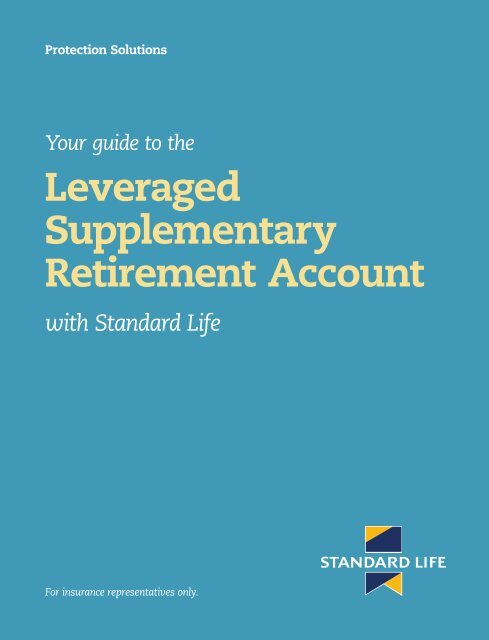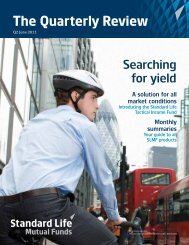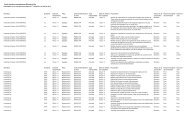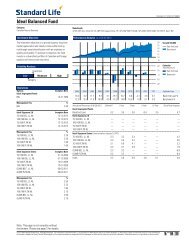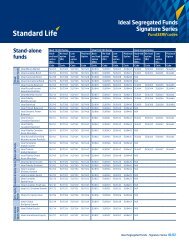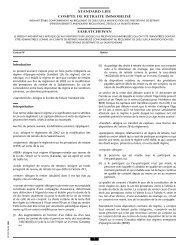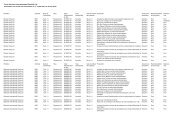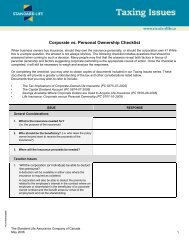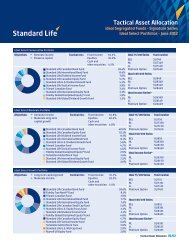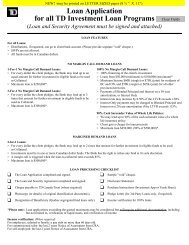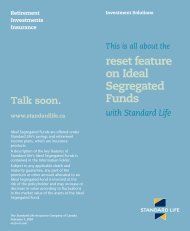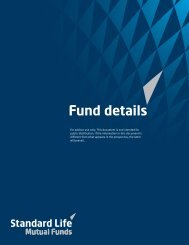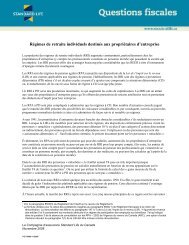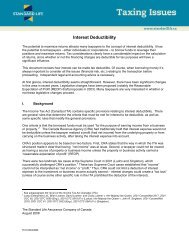Leveraged Supplementary Retirement Account - Standard Life
Leveraged Supplementary Retirement Account - Standard Life
Leveraged Supplementary Retirement Account - Standard Life
Create successful ePaper yourself
Turn your PDF publications into a flip-book with our unique Google optimized e-Paper software.
Protection Solutions<br />
Your guide to the<br />
<strong>Leveraged</strong><br />
<strong>Supplementary</strong><br />
<strong>Retirement</strong> <strong>Account</strong><br />
with <strong>Standard</strong> <strong>Life</strong><br />
For insurance representatives only.
<strong>Leveraged</strong> <strong>Supplementary</strong> <strong>Retirement</strong> <strong>Account</strong><br />
One of the challenges faced by individuals who earn a<br />
higher income is finding tax efficient ways to save for<br />
retirement. In order to maintain the same standard of living<br />
after retirement as they enjoyed prior to retirement, experts<br />
most often suggest that 70% of pre-retirement income is<br />
required. Government plans and registered plans provide<br />
sources of retirement income but income tax rules cap the<br />
amount that can be contributed to (or in the case of defined<br />
benefit arrangements, received from) employer-sponsored<br />
pension plans (RPPs) and individual Registered <strong>Retirement</strong><br />
Savings Plans (RRSPs). In fact, once “earned income” exceeds<br />
a specific amount, potential RRSP contributions for the next<br />
taxation year will be capped. 1<br />
This guide will discuss a strategy for dealing with the<br />
retirement income “gap” mentioned above. The option<br />
combines two financial vehicles, an exempt universal life<br />
insurance policy and a loan arrangement. This option will<br />
be referred to as the <strong>Leveraged</strong> <strong>Supplementary</strong> <strong>Retirement</strong><br />
<strong>Account</strong> (LSRA).<br />
1 RRSP contributions take into account the earned income for the previous<br />
year. RRSP contributions for 2008 will be maximized once earned income<br />
reaches $111,111.<br />
<strong>Standard</strong> <strong>Life</strong> 1
<strong>Leveraged</strong> <strong>Supplementary</strong> <strong>Retirement</strong> <strong>Account</strong><br />
Table of contents<br />
Table of contents<br />
Sources of retirement income 4<br />
Three ways to access investment accounts in retirement 5<br />
The LSRA concept – Collateralization 6<br />
How much will the financial institution lend against the policy? 7<br />
Who should consider the LSRA strategy? 7<br />
Benefits of the LSRA option 8<br />
Factors and risks to consider 8<br />
Using a corporation to own and leverage the life insurance policy 10<br />
Deductibility for tax purposes 11<br />
General Anti-Avoidance Rule (GAAR) 11<br />
Conclusion 11<br />
Appendix A 12<br />
This guide has been prepared for information purposes only and<br />
should not be relied on to replace professional advice.<br />
<strong>Standard</strong> <strong>Life</strong> 3
<strong>Leveraged</strong> <strong>Supplementary</strong> <strong>Retirement</strong> <strong>Account</strong><br />
Sources of retirement income<br />
Sources of <strong>Retirement</strong> Income<br />
1. Registered Plans<br />
There are a number of retirement savings<br />
vehicles that are regulated by tax and pension<br />
rules. There are tax-assisted programs to which<br />
individuals and/or their employers might<br />
contribute to help accumulate a retirement nest<br />
egg. These would include:<br />
•<br />
•<br />
Registered Pension Plans (RPPs),<br />
Deferred Profit Sharing Plans (DPSPs), and<br />
• Registered <strong>Retirement</strong> Savings Plans (RRSPs)<br />
The Income Tax Act (“ITA”) places limits on<br />
the “tax assistance” for registered plans. “Tax<br />
assistance” means the tax advantages that an<br />
employer and/or employee will receive because<br />
contributions are tax deductible and the<br />
income/growth is not taxed until withdrawal<br />
from the plan.<br />
2. Government Programs<br />
There are also government-administered<br />
programs that provide retirement income based<br />
on employment and/or residence in Canada.<br />
These programs include:<br />
• Old Age Security (OAS) and, on a needs basis,<br />
Guaranteed Income Supplement (GIS)<br />
• Programs established by the provinces<br />
(e.g., Ontario’s Guaranteed Annual Income<br />
System (GAINS))<br />
• Canada Pension Plan (CPP) and Quebec<br />
Pension Plan (QPP)<br />
4 <strong>Standard</strong> <strong>Life</strong><br />
3. Non-Registered Plans<br />
Once contributions to (or benefits received from)<br />
tax-assisted plans are maximized, those who want<br />
to ensure additional sources of funds are available<br />
in retirement must find alternate vehicles.<br />
Non tax-assisted programs that an individual or<br />
their employer might establish which would be a<br />
source of retirement income include:<br />
•<br />
•<br />
Various stock plans<br />
Various profit sharing plans<br />
• Personal savings vehicles/investment portfolios<br />
These non-registered savings mechanisms often<br />
produce income that is taxable annually. A tax<br />
deferral is available for investment in stocks that<br />
are held for the long term rather than being<br />
traded from time to time. As long as no gain is<br />
realized, no income tax is due. However, since<br />
most people use mutual funds (or segregated<br />
funds) as their vehicle for investing in stocks, and<br />
since the underlying assets are generally actively<br />
traded, gains are realized each year, triggering<br />
taxation. Regardless of which approach is used,<br />
there will come a time when the underlying stocks<br />
must be liquidated, either to produce an income<br />
or on the death of the owner or spouse, thus<br />
realizing the gains and triggering taxation.
<strong>Leveraged</strong> <strong>Supplementary</strong> <strong>Retirement</strong> <strong>Account</strong><br />
Sources of retirement income<br />
Three ways to access investment accounts in retirement<br />
4. Using a <strong>Leveraged</strong> <strong>Supplementary</strong><br />
<strong>Retirement</strong> <strong>Account</strong> (LSRA) to fund<br />
retirement<br />
This strategy involves purchasing a universal<br />
life (UL) insurance policy generally a minimum<br />
of 10 years prior to retirement. Policies that<br />
qualify as “exempt” under the ITA (most UL<br />
policies issued in Canada qualify), allow funds<br />
to accumulate within an investment account<br />
inside the policy on a tax-sheltered basis by<br />
virtue of sections 148 and 12.2 of the ITA.<br />
The other component of the policy is the life<br />
insurance component. It is separate from the<br />
investment, but both form part of the same life<br />
insurance policy.<br />
What makes universal life insurance attractive<br />
is premium flexibility. A client can deposit more<br />
or less into the plan, as long as there is enough<br />
to cover the premiums for the life insurance<br />
component. Excess contributions (up to a<br />
maximum limit calculated with reference to ITA<br />
rules) form part of the investment account in the<br />
policy that can grow on a tax-sheltered basis.<br />
Upon the death of the insured, the total death<br />
benefit is paid out tax-free to the beneficiary(ies).<br />
Tax may be payable if the policy is disposed of<br />
and the investment funds withdrawn, in whole<br />
or in part, before the death of the life insured.<br />
Three ways to access the<br />
investment accounts in<br />
retirement:<br />
1. Withdrawals from the policy<br />
2. Policy loans from the insurance company<br />
3. Collateralization with a financial institution<br />
Withdrawal from the policy<br />
Withdrawals can be made directly from the life<br />
insurance policy’s cash surrender value. When<br />
a partial withdrawal is made, the adjusted cost<br />
basis (ACB) may have an impact on the net<br />
amount withdrawn as the difference between the<br />
amount withdrawn and the ACB is taxable. The<br />
amount of the ACB is proportional to the total<br />
amount withdrawn.<br />
Policy loans<br />
Funds can also be accessed as a policy loan.<br />
In essence, these are not typical loans, but<br />
rather advance payments of the policyholder’s<br />
entitlement under the policy. The advances do<br />
not have to be repaid to the insurer. A policy loan<br />
constitutes a disposition for tax purposes and<br />
will attract taxation when the total loan amount<br />
exceeds the adjusted cost basis of the policy.<br />
The insurance company will charge interest on<br />
any outstanding balance of policy loan. Any<br />
outstanding loan balance will be deducted<br />
from the policy proceeds at death with the net<br />
amount then being paid to the beneficiary(ies).<br />
For additional information on this topic, please<br />
refer to the Taxing Issues document entitled<br />
“Policy Loans” (PC 6140).<br />
Collateralization with a financial<br />
institution<br />
Another way to access the account value of the<br />
life insurance policy is by pledging the policy<br />
as collateral for a loan or series of loans from a<br />
financial institution. At retirement, the policy may<br />
be used as collateral security, and the financial<br />
institution will grant yearly loans or a lump sum,<br />
which can provide an additional source of yearly<br />
income to meet needs in retirement. Based on<br />
current tax rules (as at November, 2007) the loan<br />
proceeds are not taxable.<br />
<strong>Standard</strong> <strong>Life</strong> 5
<strong>Leveraged</strong> <strong>Supplementary</strong> <strong>Retirement</strong> <strong>Account</strong><br />
The LSRA concept – Collateralization<br />
The LSRA concept –<br />
Collateralization<br />
The LSRA concept uses the collateralization<br />
method to access the account value in the policy<br />
and operates as follows:<br />
• The individual purchases universal life policy<br />
on his/her own life (or jointly with spouse).<br />
• The individual makes deposits (subject<br />
to certain limits under the ITA) into the<br />
investment accounts, in excess of the<br />
minimum premium required for the<br />
life insurance.<br />
• Income accumulating in the account(s) is<br />
tax-sheltered unless it is withdrawn from the<br />
policy or exceeds maximum allowable limit<br />
under the ITA.<br />
• When the individual retires and desires<br />
additional funds, the life insurance policy can<br />
be used as collateral to obtain a loan, or a<br />
series of loans, from a financial institution.<br />
• The financial institution will lend up to a<br />
specified percentage of the cash surrender<br />
value of the policy. This percentage varies<br />
depending on the type of investment account.<br />
• Loan amounts can be received as periodic<br />
payments or as a lump sum. Based on current<br />
legislation, loan proceeds are tax-free.<br />
• The loan is repaid when death proceeds<br />
are payable from the policy, unless loan<br />
repayment is demanded earlier. The residual<br />
balance of the death benefit, if any, goes to the<br />
deceased’s other beneficiaries.<br />
6 <strong>Standard</strong> <strong>Life</strong><br />
There are two ways in which the<br />
loan arrangement can generate<br />
cash for the retiree:<br />
1. Borrow a lump sum and purchase<br />
an annuity<br />
The maximum amount allowable based on the<br />
policy cash value is borrowed as a lump sum and<br />
used to purchase an annuity. This is not the most<br />
effective method. While the loan itself is tax-free,<br />
a part of the annuity income is subject to income<br />
tax every year.<br />
In addition to the income tax due, the loan<br />
interest owing must be addressed. There are two<br />
options: the interest can be paid each year if the<br />
borrower so chooses or, the interest on the loan<br />
could be capitalized each year. If the interest is<br />
capitalized, the financial institution will advance<br />
an amount equal to the interest due and use<br />
this amount to pay the interest. The net effect is<br />
that the loan increases each year by the interest<br />
amount. The initial loan amount will be set<br />
lower, so that the projected loan plus capitalized<br />
interest over the life expectancy of the borrower<br />
will not exceed the financial institution’s<br />
maximum lending ratio based on the projected<br />
cash value of the policy over the same period.
2. Receive a series of loans<br />
<strong>Leveraged</strong> <strong>Supplementary</strong> <strong>Retirement</strong> <strong>Account</strong><br />
The LSRA concept – Collateralization<br />
How much will the financial institution lend against the policy?<br />
Who should consider the LSRA strategy?<br />
A more effective method is to arrange a series<br />
of annual loans. The interest on the first loan<br />
will be capitalized (if the borrower wishes). The<br />
second loan will be added to the first, including<br />
capitalized interest and so on. The total loan<br />
at any time will be the sum of the annual loan<br />
amounts to date plus all of the capitalized<br />
interest. The annual loan amount will be set such<br />
that at the life expectancy of the borrower, the<br />
sum of all of the annual loans plus capitalized<br />
interest will not exceed the financial institution’s<br />
lending ratio based on projected cash value and<br />
the type of investment account. The attraction<br />
of the second approach is that no income tax<br />
will be payable, since all monies are received<br />
in the form of loans which are not subject to<br />
income tax.<br />
How much will the financial<br />
institution lend against the policy?<br />
The loan is secured by the policy cash value.<br />
If the funds within the policy are invested in<br />
guaranteed fixed income accounts, the financial<br />
institution will generally allow loans plus<br />
capitalized interest (if this has been elected) to<br />
accumulate to 85% to 90% of the cash value in<br />
the policy. If the funds are invested in variable<br />
accounts, such as managed accounts, the<br />
financial institution may only lend up to 50% to<br />
60% of their value.<br />
Who should consider the<br />
LSRA strategy?<br />
This strategy is most suited to the<br />
following individuals:<br />
1. An individual who has maximized<br />
contributions to (or pension benefits<br />
receivable from) employer-sponsored pension<br />
plans and RRSPs and has excess cash to invest<br />
for retirement.<br />
2. An individual who will need higher income<br />
in retirement than can be provided through<br />
a combination of government and private<br />
tax-assisted pension and RRSP plans.<br />
3. An individual who has a minimum of 10 years<br />
to accumulate additional funds before he/she<br />
will need to access the funds.<br />
4. An individual who is comfortable with<br />
borrowing strategies and understands the<br />
risks associated with them.<br />
5. Younger people who take a long-term<br />
planning perspective and can make deposits<br />
over and above the RRSP or Pension (RPP)<br />
maximums can take advantage of:<br />
• Owning a permanent, exempt policy rather<br />
than a temporary policy.<br />
• Accumulating assets in excess of the<br />
RRSP/RPP limits in an exempt policy rather<br />
than in a non-registered vehicle.<br />
<strong>Standard</strong> <strong>Life</strong> 7
<strong>Leveraged</strong> <strong>Supplementary</strong> <strong>Retirement</strong> <strong>Account</strong><br />
Benefits of the LSRA option<br />
Factors and risks to consider<br />
Benefits of the LSRA option<br />
1. Since the funds inside the policy grow on a<br />
tax-sheltered basis, it is possible to outperform<br />
traditional non-registered savings vehicles that<br />
are subject to annual taxation and therefore<br />
provide a larger after-tax source of cash flow<br />
(with the policy structured for investment<br />
purposes it is possible to minimize the face<br />
amount of the insurance thereby minimizing<br />
and ultimately eliminating its cost).<br />
2. The loan proceeds are tax-free under current<br />
legislation. Since the loan proceeds are<br />
not deemed to be income, no clawback of<br />
government benefits would be triggered by<br />
the transaction.<br />
3. The portion of the life insurance proceeds<br />
remaining after the loan balance is repaid is<br />
available for beneficiaries.<br />
4. The individual can control how much to<br />
borrow against the policy based on his/her<br />
needs. Neither the registered nor the nonregistered<br />
plans can take advantage of the<br />
loan approach. In the case of registered plans,<br />
ITA and pension rules dictate the manner and<br />
timing of withdrawals from the plan. Once<br />
withdrawn, the income is taxable.<br />
Factors and risks to consider<br />
Beneficiary designations<br />
In the Common Law provinces, if the policy<br />
owner has designated a preferred beneficiary<br />
(spouse, child, grandchild, parent of the insured)<br />
or an irrevocable beneficiary, the policy is<br />
generally creditor protected. In Quebec, the<br />
rule is different. The policy is generally creditor<br />
protected if the policy owner has designated<br />
a preferred beneficiary (his spouse, his<br />
8 <strong>Standard</strong> <strong>Life</strong><br />
descendants, his ascendants) or an irrevocable<br />
beneficiary. However, we should note that<br />
when a beneficiary has been designated to be<br />
irrevocable*, the owner’s freedom is limited<br />
with regards to the policy. Any change that<br />
could materially affect the benefit must have<br />
the consent of an irrevocable beneficiary. Thus,<br />
any pledge of the policy as security for a loan<br />
will need the signature of that beneficiary. In<br />
situations where the insured and beneficiary<br />
are estranged, an agreement may not<br />
be forthcoming.<br />
Reduction of death benefit<br />
The LSRA arrangement reduces the death benefit<br />
available to heirs. Taking a loan against the<br />
policy may deprive a beneficiary of needed cash<br />
after the death of the insured because part of the<br />
death benefit must be used to pay off the loan.<br />
Even if additional funds are required during the<br />
insured’s lifetime, the impact of a reduced death<br />
benefit should be factored into the decision to<br />
proceed with leveraging.<br />
In situations where a single life, zero guarantee<br />
annuity has been recommended as another<br />
component of retirement income planning, the<br />
life insurance death benefit is expected to be<br />
there to provide an income for the surviving<br />
spouse. If part of the death benefit is needed to<br />
pay off a loan, only a portion will remain, which<br />
may not be sufficient.<br />
*In the Common Law provinces, (all provinces<br />
except Quebec), a spouse, child, grandchild, mother<br />
or father designated as a beneficiary before<br />
July 1, 1962 will also have to give consent if the<br />
contract is to be leveraged.
Compounding effect of loan<br />
<strong>Leveraged</strong> <strong>Supplementary</strong> <strong>Retirement</strong> <strong>Account</strong><br />
Factors and risks to consider<br />
In a case where the interest is capitalized, the<br />
loan will increase each year by the amount of<br />
the interest. If the loan is in effect for a long<br />
period of time, the compounding effect of these<br />
additions may cause the loan amount to exceed<br />
the financial institution’s lending ratio based on<br />
the policy cash value and the financial institution<br />
may call the loan. Therefore, use of this loan<br />
arrangement should be restricted to applications<br />
where there is a natural limit to the likely<br />
duration of the loan. Use of the arrangement<br />
at retirement is ideal because life expectancy<br />
will tend to limit the loan duration. Since the<br />
ultimate intent is to repay the loan from the<br />
policy death benefit, the arrangement would not<br />
be appropriate if a person aged 40 or 50 were to<br />
start a series of loans today.<br />
Financial institution calls the loan<br />
If the loan were to exceed the maximum<br />
allowable percentage of the cash value, the<br />
financial institution could call the loan. If the<br />
financial institution recalls the loan, the life<br />
policy would be surrendered resulting in the loss<br />
of the tax-free death benefit and the triggering<br />
of tax on the accumulated gain. This possibility<br />
should be averted at all costs. It is especially<br />
important to note that any income tax liability<br />
arising out of a forced policy surrender is a<br />
liability for the policy owner, not the financial<br />
institution.<br />
The risk of the loan exceeding the cash<br />
value arises from three sources:<br />
1. An increase in the spread between the interest<br />
rate charged on the loan and the interest<br />
being earned within the policy.<br />
2. The time over which the loan is growing is<br />
longer than anticipated.<br />
3. The cost of insurance has a negative impact on<br />
the growth of the account.<br />
Investment risk<br />
There are risks associated with any type of<br />
investment. When debt is also incurred,<br />
additional factors must be considered. The<br />
maximum loan amount will depend on the<br />
investments held in the policy account. Financial<br />
institutions, currently, will generally loan up<br />
to 85% to 90% of the value of fixed income<br />
investments but only up to 50% to 60% of<br />
equity-linked investments. At the time of<br />
borrowing, the investment mix may need to<br />
be amended to maximize the amount that may<br />
be collateralized.<br />
Since the loan is generally a variable rate<br />
loan, the interest rate can increase without a<br />
corresponding increase in the return on the<br />
investments. Higher interest charges, if not paid<br />
yearly, can cause the outstanding loan balance<br />
to increase more rapidly and thus reducing<br />
future loan capacity. If the return on investments<br />
also drops, the fund and the maximum loan<br />
amount are also reduced. The outstanding loan<br />
and the policy account need to be monitored<br />
frequently to avoid a situation where the loan<br />
exceeds the financial institution’s ratio and<br />
forces a reduction in the loan through capital<br />
repayments or a collapse of the life policy to<br />
repay the debt.<br />
Changes in financial institution policy<br />
or tax rules<br />
Currently financial institutions make no<br />
commitment that they will continue to offer<br />
these types of loans in the future. Lending rules<br />
can change and may make this type of loan<br />
unavailable. As well, upon renewal, the financial<br />
institution may wish to change the terms of<br />
the loan. In addition, should the treatment<br />
of these loans by the tax authorities change,<br />
this arrangement could be rendered much<br />
less attractive.<br />
<strong>Standard</strong> <strong>Life</strong> 9
<strong>Leveraged</strong> <strong>Supplementary</strong> <strong>Retirement</strong> <strong>Account</strong><br />
Using a corporation to own and leverage the life insurance policy<br />
Using a corporation to own and<br />
leverage the life insurance policy<br />
There are situations where a corporation is the<br />
owner of the life insurance policy on the life of<br />
one of its shareholders. The corporation may<br />
want to leverage the policy and use the loan<br />
proceeds to redeem the shareholder’s shares<br />
as part of a retirement strategy. There could,<br />
however, be negative tax consequences if the<br />
loan proceeds are forwarded to a shareholder<br />
or employee directly, for the purpose of<br />
supplementing retirement cash flow.<br />
In general, loans to shareholders will be<br />
included in the shareholder’s income without<br />
a corresponding deduction to the corporation<br />
pursuant to subsection 15(2) of the ITA. The only<br />
way to avoid this result is for the shareholder<br />
to repay the loan within 1 year of the end<br />
of the taxation year in which the loan was<br />
made. (Note: there cannot be a series of loans<br />
and repayments). The same rule applies to<br />
employees unless the employee (and related<br />
family members) own less than 10% of any<br />
class of shares of the business. If the employee<br />
fits within the exception, the loan will not be<br />
included in income but an imputed interest<br />
benefit will be included.<br />
If the business redeems shares or distributes<br />
the loan proceeds by way of dividend to the<br />
shareholder, they will be considered taxable<br />
dividends in the hands of the shareholder.<br />
(assuming that the corporation does not have a<br />
balance in its Capital Dividend Accont (CDA) and<br />
thus cannot declare a Capital Dividend)<br />
10 <strong>Standard</strong> <strong>Life</strong><br />
<strong>Retirement</strong> Compensation Arrangement<br />
(RCA) Rules<br />
Where a corporation acquires a life insurance<br />
policy with a view to providing retirement<br />
benefits, the policy may be deemed to be an<br />
RCA pursuant to subsection 207.6(2) of the ITA,<br />
and specific tax rules will apply. This would have<br />
negative tax implications.<br />
The following rules would apply:<br />
1. The employer/corporation would be required<br />
to withhold and remit a tax equal to the<br />
amount of the insurance premium to a<br />
refundable tax account with Canada Revenue<br />
Agency (CRA).<br />
2. The employer would receive a tax deduction<br />
for twice the amount of the insurance<br />
premium.<br />
3. Refunds from the refundable tax account<br />
would be included in the income of<br />
the recipient.<br />
4. The full amount of the death benefit that is<br />
received by the employer would be taxable to<br />
the employer as a distribution from the RCA.<br />
Deductibility for tax purposes<br />
Deductibility for tax purposes of interest<br />
incurred on a loan<br />
The general rule is that interest is only<br />
deductible for tax purposes when it is paid or<br />
payable pursuant to a legal obligation to pay,<br />
and when the proceeds of the loan are used for<br />
the purpose of earning income from a business<br />
or property (paragraph 20(1)(c) of the ITA). With<br />
the LSRA strategy, where an individual leverages<br />
the policy and the loan proceeds are used for<br />
personal living expenses, the interest would not<br />
be deductible since the borrowed funds are not<br />
used to gain or produce income.
<strong>Leveraged</strong> <strong>Supplementary</strong> <strong>Retirement</strong> <strong>Account</strong><br />
Deductibility for tax purposes<br />
General Anti-Avoidance Rule (GAAR)<br />
Conclusion<br />
In cases where a business leverages the life<br />
insurance policy, one must look at the facts on<br />
a case-by-case basis to determine if interest will<br />
be deductible.<br />
On October 31, 2003, the Department of<br />
Finance introduced proposals relating to<br />
interest deductibility. If a deduction is to be<br />
sought for the interest paid on any borrowings,<br />
the borrower should consult their tax advisor<br />
as to the impact of these proposed rules. For<br />
additional information on this topic, please refer<br />
to the Taxing Issues document entitled, “Interest<br />
Deductibility” (PC 6141).<br />
Deductibility for tax purposes of life<br />
insurance annual premiums<br />
A policyholder may be able to deduct all or a<br />
portion of the life insurance premiums where<br />
the policy is used as collateral, provided that<br />
the policy is assigned to a restricted financial<br />
institution, the interest incurred on the loan<br />
is deductible, and the restricted financial<br />
institution requires the policy as collateral.<br />
The amount deductible is to be capped at the<br />
lesser of the premiums payable in respect of<br />
the year, and the Net Cost of Pure Insurance<br />
(NCPI) for that year. It will also need to be related<br />
to the amount owed versus the life insurance<br />
coverage amount.<br />
For additional information on this topic, please<br />
refer to the Taxing Issues document entitled,<br />
“Leveraging <strong>Life</strong> Insurance Policies” (PC 6244).<br />
General Anti-Avoidance Rule<br />
(GAAR)<br />
Subsection 245(2) of the ITA contains a provision<br />
called the General Anti-Avoidance Rule (GAAR).<br />
The provision allows CRA to recharacterize a<br />
transaction if the transaction is a misuse or<br />
abuse of the provisions of the Act. If CRA applied<br />
GAAR to leveraged insurance transactions, it<br />
might attempt to recharacterize the loan from<br />
the financial institution as a policy loan. If it is<br />
deemed to be a policy loan, amounts in excess<br />
of the policy’s adjusted cost basis would be<br />
taxable. It is arguable that GAAR should not<br />
apply to recharacterize the loan. One argument<br />
is that a policy loan is defined in the Act to be an<br />
amount advanced by an insurer in accordance<br />
with the terms of the policy. Since the insurer is<br />
not advancing the funds in accordance with the<br />
terms of the policy, the transaction should not fit<br />
within the definition of policy loan.<br />
Conclusion<br />
As with any investment option, it is important to<br />
review both the risks and rewards. In the right<br />
situation, an LSRA can provide additional cash<br />
flow in retirement and provide permanent life<br />
insurance for the individual’s beneficiaries.<br />
<strong>Standard</strong> <strong>Life</strong> 11
<strong>Leveraged</strong> <strong>Supplementary</strong> <strong>Retirement</strong> <strong>Account</strong><br />
Appendix A<br />
Appendix A – Comparison of features of LSRA,<br />
registered plans and non-registered plans<br />
Type of Plan Deposits<br />
into Plan<br />
12 <strong>Standard</strong> <strong>Life</strong><br />
Accumulating<br />
Assets<br />
Registered Plans Tax-deductible Tax sheltered while in<br />
the plan<br />
Non-registered Plans /<br />
Portfolio Investments<br />
Accumulation in an<br />
Exempt <strong>Life</strong> Policy<br />
After-tax deposits Taxable subject to type<br />
of income earned<br />
After-tax deposits Accumulating assets<br />
tax-sheltered while in<br />
the policy<br />
Cash Flow<br />
from Plan<br />
Taxable when<br />
withdrawn<br />
After-tax capital not<br />
subject to taxation<br />
Taxable if withdrawn<br />
or loan taken out from<br />
policy; if leveraged<br />
loan is used, proceeds<br />
from loan not taxable
<strong>Retirement</strong><br />
Investments<br />
Insurance<br />
Talk soon.<br />
www.standardlife.ca<br />
The <strong>Standard</strong> <strong>Life</strong> Assurance Company of Canada<br />
5477C-02-2008


